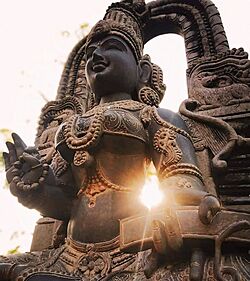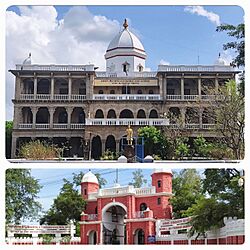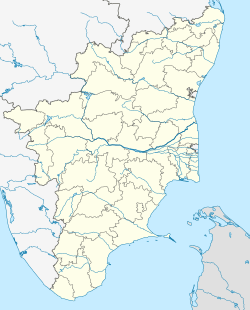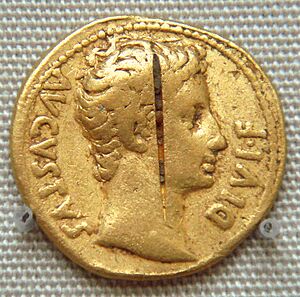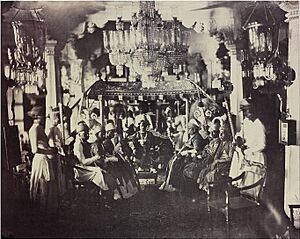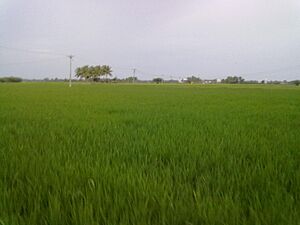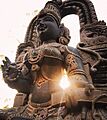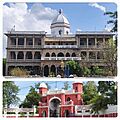Pudukkottai facts for kids
Quick facts for kids
Pudukkottai
Heritage and Historical City of Tamilnadu
|
|
|---|---|
|
1)Tamil Goddess Statue, Sittannavasal, 2)District Collector Office, Pudukkottai; 3)District Court, Pudukkottai, 4) Sittannavasal Cave Temple, 5)Thirumayam Fort.
|
|
| Nickname(s):
pudugai , Thondaiman Pudukkottai
|
|
| Country | |
| State | |
| District | Pudukkottai |
| Collector | Mrs. M.Aruna, I.A.S |
| Superintendent of Police | Vandita Pandey, IPS |
| Government | |
| • Type | Municipal Corporation |
| • Body | Pudukkottai City Municipal Corporation |
| Area | |
| • Total | 121.26 km2 (46.82 sq mi) |
| Elevation | 116 m (381 ft) |
| Population
(2024)
|
|
| • Total | 225,500 |
| • Density | 1,859.6/km2 (4,816.4/sq mi) |
| Demonym(s) | Pudukkottaikaran |
| Languages | |
| • Official | Tamil |
| Time zone | UTC+5:30 (IST) |
| PIN |
622001 - 622006
|
| Telephone code | 04322 |
| Vehicle registration | TN-55 |
| Sex ratio | 995 per 1,000 males ♂/♀ |
Pudukkottai is an old and historic city in the Indian state of Tamil Nadu. It is the main city of the Pudukkottai district. People sometimes call it Thondaiman Pudukkottai. The city is located near the Vellar River.
Many different groups have ruled Pudukkottai over time. These include the Mutharaiyar dynasty, Cholas, Early Pandyas, Thondaimans, and the British. The city is about 372 kilometers (231 miles) southwest of Chennai, the state capital.
Pudukkottai is known as the "city of the cradle of archeology." This means it has many ancient historical sites. It is also the home of Santhi Soundarajan, Tamil Nadu's first woman to compete in the Asian Games.
As a district headquarters, Pudukkottai has important government offices. It also has many schools and colleges. The city is managed by a Municipal Corporation. This corporation was first set up in 1912. In 2024, the city was officially upgraded to a corporation.
Contents
A Look Back in Time
The princely state of Pudukottai was created by Ragunatha Kilavan Sethupati. He was a ruler from Ramnad. He gave the area of Pudukkottai to his brother-in-law, Ragunatha Thondaiman. Ragunatha Thondaiman had previously ruled Thirumayam.
After becoming ruler, Ragunatha Thondaiman fought against the Nayaks of Thanjavur. He helped the Nayaks of Madurai. He also took over an important place called Thirukkattupalli. Later, the Thondaiman rulers often acted independently, even though they were linked to Ramnad.
Thondaiman Rulers and Their Battles
The next ruler, Raja Vijaya Reghunatha Raya Thondaiman, helped the Arcot Nawab. They fought against Hyder Ali, the ruler of Mysore. Thondaiman was also loyal to the British Government. When Hyder Ali's army tried to enter Pudukkottai, Thondaiman's army pushed them back. Thondaiman also captured Kilanilai and Aranthangi.
Pudukkottai later came under the protection of the British. This was important because Hyder Ali and Tipu Sultan from Mysore were a big threat. When Tipu Sultan worked with the French against the British, Pudukkottai decided to join the British. This was a common choice for many states at that time.
The last ruler in the Thondaiman line was Raja Rajagopala Thondaiman. He became king when he was only six years old. After India became independent in 1947, the Pudukkottai Princely State joined the Indian Union. This happened on April 3, 1948. This marked the end of the long rule of the Thondaiman kings.
Important Kings of Pudukkottai
Some of the main kings from this family include:
- Tondaiman (1686–1730)
- Vijaya Raghunatha Raya Tondaiman (1730–1769)
- Raya Raghunatha Tondaiman (1769 – 1789)
- Vijaya Raghunatha Tondaiman (1789 – 1807)
- Vijaya Raghunatha Raya Tondaiman (1807 – 1825)
- Raghunatha Tondaiman (1825 – 1839)
- Ramachandra Tondaiman (1839 – 1886)
- Marthanda Bhairava Tondaiman (1886 – 1928)
- Rajagopala Tondaiman (1928 – 1948)
Pudukkottai became a princely state under British rule. In 1901, it had about 380,000 people. The last Thondaiman raja joined independent India in 1948. On January 14, 1974, the current Pudukkottai District was formed.
City Geography and Climate
Pudukkottai is located at 10.38°N 78.82°E, in the valley of the Vellar River. The city has a dry climate. This means it has high temperatures all year and not much rain.
Pudukkottai is mostly flat, but it has some rocky hills nearby. These hills include Urugumalai, Athimalai, and Chennaimalai. The main rivers flowing in the area are Amaravathy, Noyal, Bhavani, and Kaveri.
The soil in Pudukkottai is mostly red loam and red sand. Farmers here grow crops like paddy (rice), groundnuts, bananas, and sugarcane.
Weather in Pudukkottai
Pudukkottai is hot and dry most of the year. Temperatures can go from a high of 39.7°C (103.5°F) to a low of 17.8°C (64.0°F). The hottest months are April to June. The coolest months are December to January.
The city gets about 978.8 millimeters (38.54 inches) of rain each year. Most of the rain comes during the North-East monsoon. This happens in October, November, and December. The Southwest monsoon, from June to August, brings less rain. The city covers an area of 21.25 square kilometers (8.20 sq mi).
People and Culture
| Religious census | ||||
|---|---|---|---|---|
| Religion | Percent(%) | |||
| Hindu | 88.28% | |||
| Muslim | 5.86% | |||
| Christian | 6.13% | |||
| Sikh | 0.02% | |||
| Other | 0.26% | |||
| No religion | 0.26% | |||
| Historical population | ||
|---|---|---|
| Year | Pop. | ±% |
| 1961 | 50,428 | — |
| 1971 | 66,384 | +31.6% |
| 1981 | 87,952 | +32.5% |
| 1991 | 99,058 | +12.6% |
| 2001 | 109,217 | +10.3% |
| 2011 | 117,745 | +7.8% |
Sources:
|
||
In 2011, Pudukkottai had a population of 117,745 people. For every 1,000 males, there were 1,003 females. This shows a good balance between genders. The city also has a high literacy rate of 91.35%. This means most people can read and write.
The Thondaiman king, Vijaya Raghunatha, rebuilt the town. He planned it so that the main streets crossed each other at right angles. The palace was in the very center.
Most of the land in Pudukkottai is developed. About 60.1% of the city is for homes. Businesses take up 4.43% and industries take up 1.47%. The population is densest in the city center. It is less dense in areas like Sivagandapuram and Ganesh Nagar.
Most people in Pudukkottai are Hindus. Muslims and Christians are the next largest groups. The main language spoken is Tamil. However, English is also commonly used. Many schools and offices use English.
Getting Around Pudukkottai
The Pudukkottai municipality takes care of 122.84 kilometers (76.33 miles) of roads. This includes concrete roads, gravel roads, and paved roads.
Road Connections
Two national highways pass through Pudukkottai. These are NH 336 (Trichy - Ramanathapuram road) and NH 36 (Vikravandi - Manamadurai road). There are also two state highways: SH 26 (Trichy - Mimisal road) and SH 71 (Musiri - Sethubavachatram road).
The Pudukkottai bus stand is a main hub for buses. It has buses that travel long distances to cities like Chennai and Bengaluru. Local buses connect Pudukkottai to many nearby towns and cities.
Train and Air Travel
Pudukkottai railway station has daily express trains to Chennai and Rameswaram. There are also weekly express trains to other cities like Coimbatore and Puducherry. Passenger trains connect to Trichy, Manamadurai, and Karaikudi.
The closest airport is Tiruchirapalli International Airport. It is about 45 kilometers (28 miles) away from Pudukkottai.
Fun Places to Visit
Pudukkottai has several interesting places to explore:
- Sittannavaasal: This place has ancient drawings and stone beds.
- Government Museum: This is the second largest museum in Tamil Nadu.
- Thirumayam Fort: An old and historic fort.
- Pudukulam: A big man-made tank that provides water for the town.
- Pudukkottai palace: A grand palace where an 18th-century saint's sand casket is kept.
Pudukkottai's Economy
The SIPCOT Industrial Complex is located on the Tiruchirappalli - Rameswaram National Highway. This industrial area is well connected by road, rail, and air. It was started in 1980 for engineering and general industries.
Pudukkottai district is mainly an agricultural area. The climate is usually dry and hot. So, farming here depends a lot on rainfall. The average rainfall is 922.8 mm per year. Most of this rain comes during the North-East Monsoon.
Farming in Pudukkottai
There are 5,451 irrigation tanks in the district. These tanks help store water for farming. About 172 of these tanks get water from the Grand Anaikat Channel. The rest depend on rain. There are also about 47,583 wells that water farms.
Paddy is the main crop grown here. About 90,000 hectares of land are used for paddy. Some of this land gets water from the Kaveri Mettur Project. The rest is watered by wells and tanks.
Besides paddy, groundnut is another major crop. It is mostly grown when there is enough rain. Other crops include Millet, pulses, cotton, sugarcane, and gingelly.
Schools and Services
As of 2011, Pudukkottai had 33 schools. This included primary, middle, high, and higher secondary schools. There were also three arts and science colleges. These were H.H. The Rajah's College for men, Govt. Arts College for Women, and Govt. College of Education. The town also had five industrial training institutes (ITIs).
Utilities and Healthcare
The Tamil Nadu Electricity Board (TNEB) provides electricity to Pudukkottai. Water supply comes from the Cauvery river. It is brought from Jeyapuram and Ammaiyappatti water works. In 2000–2001, about 7 million liters of water were supplied daily.
The Pudukkottai Municipality collects about 30-35 metric tonnes of solid waste every day. They collect it from homes and then sort and dump it. The town does not have an underground drainage system. Waste water is managed through septic tanks and open drains.
In 2011, the municipality maintained 191 kilometers (119 miles) of storm water drains. There were also 31 hospitals, dispensaries, and clinics. These take care of the health needs of the people. The municipality also maintains 4,039 street lamps. They run one weekly market, two daily vegetable markets, and one daily fish market.
Colleges and Schools in Pudukkottai
Some of the important schools and colleges are:
- Agricultural College & Research Institute, Kudumiyanmalai
- Government Arts College for Women, Pudukkottai
- Government Medical College and Hospital, Pudukkottai
- H. H. The Rajah's College, Pudukkottai
- Mookambigai College of Engineering
- Mount Zion College of Engineering and Technology
- Mount Zion College of Nursing
- Valampuri Vaduganathan Higher Secondary School
- Vidyaa Vikas Higher Secondary School
Sports in Pudukkottai
Pudukkottai has a famous sports club called Kavinadu Sports Club. This club trains young and talented athletes. These athletes do well in sports at district, state, national, and even world levels.
Two important long-distance runners from India, Miss. Surya and Mr. Lakshmanan, trained at this club. In 2017, Lakshmanan won gold medals in both 5,000 and 10,000 meters running at the Asian Athletic championship. He was the first Indian to win two gold medals there. He also competed in the world championships in London in 2017.
Images for kids
See also
 In Spanish: Pudukkottai para niños
In Spanish: Pudukkottai para niños


